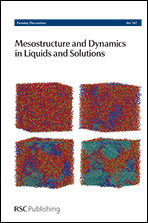Dynamics and vibrational spectroscopy of water at hydroxylated silica surfaces†
Abstract
In the present study, the structural and dynamical properties of water at hydroxylated silica surfaces are investigated with classical molecular dynamics simulations. Depending on the nature of the interface, water molecules are observed to have well defined ordering and slower dynamics compared to bulk water. These properties include the orientation of water near the surface, reorientational relaxation times, translational diffusion coefficients, planar density distribution and vibrational spectroscopic features. The dynamical and structural features are affected up to ≈6–10 Å away from the surface, depending on the properties considered (lateral diffusion coefficient, charge density profile, rotational orientational time). Water molecules at the silica surface show a marked decrease in the diffusion coefficient and an increase in rotational correlation times. The presence of the polar –OH group on the hydroxylated silica surface provides adsorption sites for water with preferred orientations. In addition to the known broadening of the water spectrum in the bonded OH-stretch region for first-layer water molecules, the present simulations find a characteristic band at 1150 cm−1, which is assigned to the HO(water)–H(SiOH) bending vibration. Because this signal only occurs for water molecules in the first layer, it should be experimentally accessible through surface sensitive techniques such as vibrational sum frequency generation spectroscopy (VSFG).
- This article is part of the themed collection: Mesostructure and Dynamics in Liquids and Solutions

 Please wait while we load your content...
Please wait while we load your content...